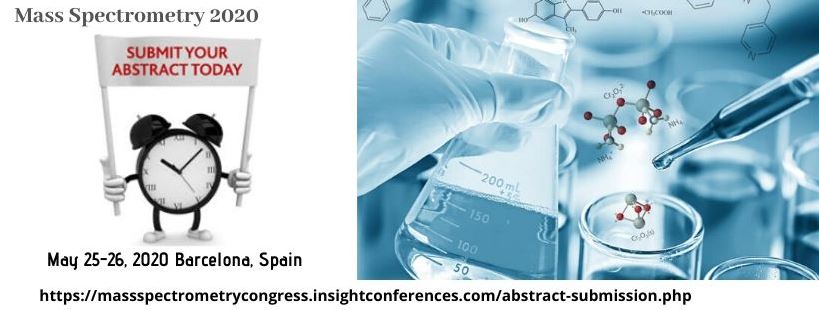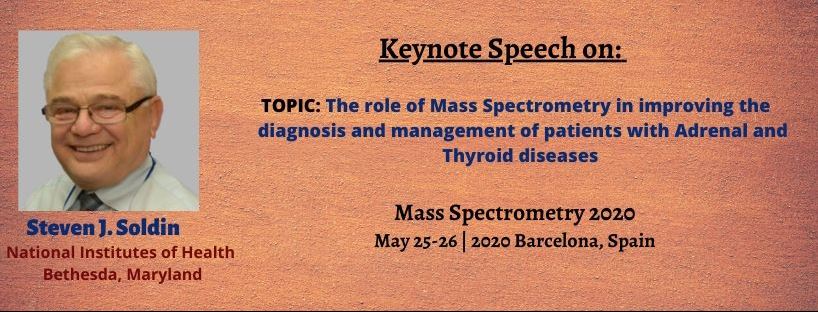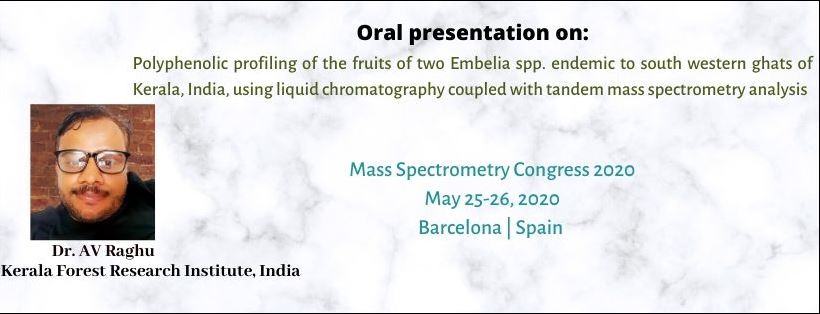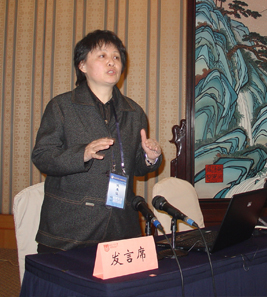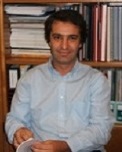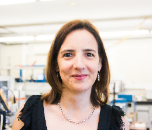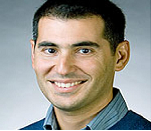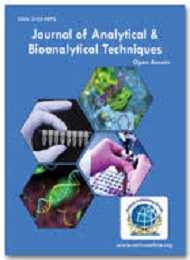Theme: Utilising the latest developments in Mass Spectrometry and Chromatography
Mass Spectrometry Congress 2020
Welcome To Mass Spectrometry Congress 2020
Conference Series LLC LTD invites all the participants from all over the world to attend 9th International Conference On Mass Spectrometry And Chromatography during May 25-26, 2020 that will conduct ONLINE which includes prompt keynote presentations, Oral talks, Poster presentations and Exhibitions.
Mass spectrometry congress 2020 is a unique opportunity to discuss best practices within the laboratory research and those in other industries if the people are doing related things getting a variety of viewpoints can help us see where we can change or improve our own ideas and processes. Mass spectrometry congress 2020 conference designed in all aspects of application including electrospray ionization and mass spectrometry imaging. There will be many seminars, workshops and technical sessions take place which will catch the attention of the professionals to attend Mass spectrometry congress 2020 conference and it would enormously enrich our knowledge in understanding the current requirements of the global pharmaceutical industry and LCMS/GCMS. The expert will get an excellent opportunity to give many presentations and lectures on different topic and will also present their case studies.
Mass Spectrometry Congress 2020 welcomes all the contributors of Mass Spectrometry and Chromatography to participate in the forthcoming Mass Spectrometry and Chromatography conference which runs with the theme "Application of Mass Spectrometry and Chromatography with beneficial impact in detecting COVID-19" during May 25-26, 2020 Webinar
Mass Spectrometry plays a fascinating role with a myriad of different applications in biology, chemistry, and physics and also in clinical bio-medicine and even in space technology.
Mass spectrometry (MS) is potentially the most important analytical spectroscopic tool of modern times. Sir J.J. Thomson, a Nobel Laureate, also known for the discovery of electrons built the first rudimentary mass spectrometer in 1913. He stated in the preface of his book named Rays of Positive Electricity and Their Application to Chemical Analyses that “Many problems in Chemistry which could be solved with far greater ease by this than by any other method”.
Track 1: Application Of Mass Spectrometry
- Application of Mass Spectrometry includes the ion and weights separation. The samples are usually introduced through a heated batch inlet, heated direct insertion probe, or a gas chromatograph. Ionization mass spectrometry (ESI-MS) which has become an increasingly important technique in the clinical laboratory for structural study or quantitative measurement of metabolites in a complex biological sample.
- MS/MS applications are plentiful. Mass spectrometry is an analytical method with high specificity and a growing presence in laboratory medicine. Various types of mass spectrometers are being used in an increasing number of clinical laboratories around the world, and, as a result, significant improvements in assay performance are occurring rapidly in areas such as toxicology, endocrinology, and biochemical markers. This review serves as a basic introduction to mass spectrometry, its uses, and associated challenges in the clinical laboratory and ends with a brief discussion of newer methods with the greatest potential for Clinical and Diagnostic Research.
Track 2: New Approaches In Mass Spetrometry
- The search of metabolites which are present in biological samples and the comparison between different samples allow the construction of certain biochemical patterns.
- The mass spectrometry (MS) methodology applied to the analysis of biological samples makes it possible for the identification of many metabolites. The 100 chromatograms were concatenated in a vector. This vector, which can be plotted as a continuous (2D pseudospectrum), greatly simplifies for one to understand the subsequent dimensional multivariate analysis.
- To validate the method, samples from two human embryos culture medium were analyzed by high-pressure liquid chromatography–mass spectrometry (HPLC–MS). They work on the principle that many microorganisms have their own unique mass spectral signature based on the particular proteins and peptides that are present in the cells. Identification of unknown peaks in gas chromatography (GC/MS)-based discovery metabolomics is challenging, and remains necessary to permit discovery of novel or unexpected metabolites that may allergic diseases processes and/or further our understanding of how genotypes relate to phenotypes. Here, we introduce two new technologies and advances in pharmaceutical analytical methods that can facilitate the identification of unknown peaks. First, we report on a GC/Quadrupole-Orbitrap mass spectrometer that provides high mass accuracy, high resolution, and high sensitivity analytic detection.
Track 3: Recent Advances In Mass Spectrometry
- New mass spectrometry (MS) methods, collectively known as data independent analysis and hyper reaction monitoring, have recently emerged. The analysis of peptides generated by proteolytic digestion of proteins, known as bottom-up proteomics, serves as the basis for many of the protein research undertaken by mass spectrometry (MS) laboratories.
- Discovery-based or shotgun proteomics employs data-dependent acquisition (DDA). Herein, a hybrid mass spectrometer first performs a survey scan, from which the peptide ions with the intensity above a predefined threshold value, are stochastically selected, isolated and sequenced by product ion scanning. n targeted proteomics, selected environmental Monitoring (ERM), also known as multiple reaction monitoring (MRM), is used to monitor a number of selected precursor-fragment transitions of the targeted amino acids. The selection of the SRM transitions is normally calculated on the basis of the data acquired previously by product ion scanning, repository data in the public databases or based on a series of empirical rules predicting the Enzyme structure sites.
Track 4: Mass Spectrometry Imaging
- Mass spectrometry imaging is a technique used in mass spectrometry to visualize the spatial distribution of chemical compositions e.g. compounds, biomarker metabolites, peptides or proteins by their molecular masses. Although widely used traditional methodologies like radiochemistry and immunohistochemistry achieve the same goal as MSI, they are limited in their abilities to analyze multiple samples at once, and can prove to be lacking if researchers do not have prior knowledge of the samples being studied.
- Emergency Radiology in the field of MSI are MALDI imaging and secondary ion mass spectrometry imaging (SIMS imaging). Imaging Mass Spectrometry is a technology that combines advanced analytical techniques for the analysis of biomedical Chromatography with spatial fidelity. An effective approach for imaging biological specimens in this way utilizes Matrix-Assisted Laser Desorption Ionization Mass Spectrometry (MALDI MS). Briefly, molecules of interest are embedded in an organic matrix compound that assists in the desorption and ionization of compounds on irradiation with a UV laser. The mass-to-charge ratio of the ions are measured using a Tandem Mass Spectrometry over an ordered array of ablated spots. Multiple analytes are measured simultaneously, capturing a representation or profile of the biological state of the molecules in that sample at a specific location on the tissue surface
Track 5: Fundamentals of Mass Spectrometry
- Mass spectrometry is an analytical tool used for measuring the molecular mass of a sample. Ionization is the atom or molecule is ionized by knocking one or more electrons off to give a positive ion. This is true even for things which you would normally expect to form negative ions or never form ions at all.
- Most mass spectrometers work with positive ions. New Ion activation methods for tandem mass spectrometry; this is followed by tandem mass spectrometry, which implies that the activation of ions is distinct from the laboratory research, and that the precursor and product ions are both characterized independently by their mass/charge ratios.
- As per the Frost and Sullivan report pharmaceutical analytical market is growing on an average 0.4% annually. This report studies the global mass spectrometry market over the forecast period of 2013 to 2018. Once analyte ions are formed in the gas phase, a variety of mass analyzers are available and used to separate the ions according to their mass-to-charge ratio (m/z). Mass spectrometers operate with the dynamics of charged particles in electric and magnetic particles in vacuum described by the Lorentz force law and Newton’s second law of motion.
Track 6: Ionization Techniques
- There are many types of ionization techniques are used in mass spectrometry methods. The classic methods that most chemists are familiar with are electron impact (EI) and Fast Atom Bombardment (FAB). These techniques are not used much with modern mass spectrometry except EI for environmental work using GC-MS.
- Electrospray Ionization (ESI) - ESI is the ionization technique that has become the most popular ionization technique. The electrospray is created by putting a high voltage on a flow of liquid at atmospheric pressure, sometimes this is assisted by a concurrent flow of gas.
- Atmospheric Pressure Chemical Ionization (APCI) - APCI is a method that is typically done using a similar source as ESI, but instead of putting a voltage on the Electrospray Tandem Mass Spectrometry Newborn Screening itself, the voltage is placed on a needle that creates a corona discharge at atmospheric pressures.
- Matrix Assisted Laser Electrophoresis is a technique of ionization in which the sample is bombarded with a laser. The sample is typically mixed with a matrix that absorbs the radiation biophysics and transfer a proton to the sample Gas Phase Ionization.
Track 7: Mass Spectrometry Configurations and Sample preparation Techniques
- Mass Spectrometry Configurations and Techniques is regards to Mass Spectrometry configuration of source, analyzer, and detector becomes conventional in practice, often a compound acronym arises to designate it, and the compound acronym may be better known among nonspectrometrists than the component acronyms.
- The Mass Spectrometry instrument consists of three major components those are Ion Source : For producing gaseous ions from the substance being studied; Analyzer: For resolving the ions into their characteristics mass components according to their mass-to-charge ratio and Detector System: For detecting the ions and recording the relative abundance of each of the resolved ionic species.
- A Imaging Mass Spectrometry is simply a device designed to determine the mass of individual atoms or molecules. Atoms of different elements have different masses and thus knowledge of the molecular mass can very often be translated into knowledge of the chemical species involved. TOF MS is the abbreviation for Time of Flight Mass Spectrometry . Charged ions of various sizes are generated on the sample slide and MALDI is the abbreviation for "Matrix Assisted Laser Desorption/Ionization."
- Mass spectrometry consists basically of weighing ions in the gas phase. The instrument used could be considered as a sophisticated balance which determines with high precision the masses of individual atoms and molecules. Depending on the samples chemical and mechanical propertiess, different ionization techniques can be used. One of the main factor in choosing which ionization technique to be used is biochemical process. For samples that are not themolabile and relatively volatile, ionization such as Electron Impact and/or Chemical Ionization can be effectively used.
Track 8: Chromatography and High Performance Liquid Chromatography (HPLC)
- Liquid chromatography-mass spectrometry analysis of small molecules from biofluids requires sensitive and robust assays. Because of the very complex nature of many biological samples, efficient sample preparation protocols to remove unwanted components and to selectively extract the compounds of interest are an essential part of almost every bioanalytical workflow.
- High-performance liquid chromatography (HPLC) is a separation technique that can be used for the analysis of organic molecules and ions. HPLC is based on mechanisms of adsorption, partition and ion exchange, depending on the type of stationary phase used. HPLC involves a solid stationary phase, normally packed inside a stainless-steel column, and a liquid mobile phase. Separation of the components of a solution results from the difference in the relative distribution ratios of the solutes between the two phases.
- HPLC can be used to assess the purity and/or determine the content of many pharmaceutical bioprocessing substances. It can also be used to determine enantiomeric composition, using suitably modified mobile phases or chiral stationary phases. Individual separation mechanisms of adsorption, partition and ion exchange rarely occur in isolation since several principles act to a certain degree simultaneously in a very environmental monitoring, hydrophilic molecules will tend to associate with each other (like water drops on an oily surface).
- The hydrophilic molecules in the mobile phase will tend to adsorb to the surface on the inside and outside of a particle if that surface is also hydrophilic. Increasing the polarity of the mobile phase will subsequently decrease the adsorption and ultimately cause the sample molecules to exit the column. This mechanism is called Normal Phase Analytical Chromatography. It is a very powerful technique that often requires non-polar solvents. Due to safety and environmental concerns this mode is used mostly as an analytical technique and not for process applications.
Track 9: Maintenance, Troubleshooting, Data Analysis and Experimentation in mass spectrometry
- Mass spectrometry experiment (MS) is a high-throughput experimental method that characterizes molecules by their mass-to-charge ratio. The MS is composed of sample preparation, molecular ionization, detection, and instrumentation analysis processes.
- MS is beneficial in that it is generally fast, requires a small amount of sample, and provides high accuracy measurements. For these reasons, MS alone or combined with other structural proteomics techniques is widely used for various molecular biology analysis purposes. Examples of the analysis include post-translations modifications in proteins, identification of vibrational components in proteins, and analysis of protein conformation and dynamics.
- We will focus on MS-coupled methods that provide information about conformation and dynamics of the protein being studied. For a comprehensive review on MS procedures and for a review on various types of MS-coupled methods. The performance of a mass spectrometer will be severely impaired by the lack of a good vacuum in the ion transfer region of the mass Analyzer. As the vacuum deteriorates it will become insufficient to maintain biomedical instrumentation in the operating mode. If the foreline pump is not maintained, the oil may become so contaminated that the optimum pumping is no longer possible. Initially, gas transport and metabolism ballasting may clean the oil.
- If the oil has become discoloured then it should be changed according to the pump manufacturers’ maintenance manual. When rotary pumps are used to pump away conflict resolution, the solvent can become dissolved in the oil causing an increase in backing line pressure. Gas ballasting is a means of purging the oil to remove dissolved contaminants
Track 10: Mass Spectrometry in Proteome Research
Mass spectrometry (MS) - based proteomics allows the sensitive and accurate quantification of almost complete proteomes of complex biological fluids and tissues. At the moment, however, the routinely usage of MS-based proteomics is prevented and complicated by the very complex work flow comprising sample preparation, chromatography, MS measurement followed by data processing and evaluation. The new technologies, products and assays developed by Precision Proteomics could help enabling and establishing mass spectrometry (MS) - based proteomics in academic and pharmaceutical research as well as in clinical diagnostics.
Track 11: Proteomics from Discovery to Function and its applications
- Proteomics has become an essential tool for understanding biological systems processes at the molecular level. Plant Proteomics publishes novel and significant research in the field of proteomics that examine the dynamics, functions, and interactions of proteins from plant systems.
- Nutritional proteomics is quickly developing to utilize little atom substance profiling to bolster incorporation of eating regimen and sustenance in complex biosystems research. Nutrigenomics is a branch of nutritional genomics and is the study of the effects of foods and food constituents on gene expression.
- Foodomics has been recently defined as a new discipline that studies food and nutrition domains through the application of advanced technologies in which MS techniques are considered indispensable. Applications of Foodomics include the genomic, transcriptomic, proteomic, and/or metabolomic study of foods for compound profiling, authenticity, and/or biomarker-detection related to food quality or safety; the development of new transgenic foods, food contaminants, and whole toxicity studies; new investigations on food bioactivity, food effects on human health.
- The University of Michigan Nutrition Obesity Research Center (UM NORC) started in 2010, supported by the National Institute of Diabetes and Digestive and Kidney Diseases (NIDDK). The UM NORC is one of 12 U.S. focuses intended to move and backing translational, multi-disciplinary exploration in heftiness and sustenance, over the continuum of fundamental science to applications in people (solution) and populations (public health).
Track 12: Application Of Chromatography
- Chromatography plays an important role in many pharmaceutical industries and also in the chemical and food industry. Environmental testing laboratories generally want to identify for very small quantities of contaminants such as PCBs in waste oil, and pesticides.
- The Environmental Protection Agency makes the method of chromatography to test drinking water and to monitor air quality. Pharmaceutical industries use this method both to prepare huge quantities of extremely pure materials, and also to analyze the purified compounds for trace contaminants.
- The other applications of chromatography especially HPLC is used in Protein Separation like Insulin Purification. Plasma Fractionation and Enzyme Purification. These separation techniques like chromatography gain importance in different kinds of companies, different departments like Fuel Industry, biotechnology, biochemical processes, and forensic science. Chromatography is used for quality analyses and checker in the food industry, by identifying and separating, analyzing additives, vitamins, preservatives, proteins, and amino acids. Chromatography like HPLC is used in DNA fingerprinting and bioinformatics.
Track 13: Mobile phases in HPLC
- Mobile phase is the most important parameter in reversed-phase HPLC. Type of mobile phase used may have a big effect on the retention. It can promote or suppress an ionization of the analyte molecules, and it also can shield an accessible residual silanol or any other active adsorption centers on the adsorbent surface.
- Proper selection of the mobile phase is the second most important step in the development of the separation method (the first one is the selection of the adsorbent type). The main requirement for the mobile phase is that it has to dissolve the analytes up to the concentration suitable for the detection. Variation of the eluent composition provides the great flexibility of HPLC separations.
Track 14: RT and RRT in HPLC
Relative retention time (RRT) is used to know where peaks apart from main compound elutes in HPLC analysis (RRF) : Relative Response factor (RRF) comes into picture when our compound and impurities have different wavelength maxima. In order to calculate the actual value of impurities' a correction factor is applies.
Track 15: Resolution in HPLC
The resolution of a elution is a quantitative measure of how well two elution peaks can be differentiated in a chromatographic separation. It is defined as the difference in retention times between the two peaks, divided by the combined widths of the elution peaks.
Track 16: Principles of Chromatography
When a solute in a solvent (or a mobile phase) is passed through or around the outside of a matrix (or a stationary phase), interactions occur between the solute and the stationary phase. Solutes with different properties are separated based on differences in these interactions.
Track 17: Principles of Mass Spectrometrty
Organic molecule bombarded with electron converted into highly energetic positive ions further breakup into smaller ions. The formed ions are seprated by deflection in magnetic field according to tgeir mass and charge.
Track 18: Components of Mass Spectrometery
Inlet system, ion source, mass analysers, ion detector, vaccum system.
Track 19: Tandem Mass Spectroscopy
- Tandem Mass Spectrometry, also known as MS/MS or MS2, is a technique in Instrumental chemistry where two or more mass spectrometers are coupled together using an additional reaction step to increase their abilities to analyse chemical samples.
- A common use of tandem-MS is the analysis of biomolecules, such as proteins and peptides.The molecules of a given sample are ionized and the first spectrometer (designated MS1) separates these ions by their mass-to-charge ratio (often given as m/z or m/Q). Ions of a particular m/z-ratio coming from MS1 are selected and then made to split into smaller fragment ions, e.g. by collision-induced dissociation, ion-molecule reaction, or photo dissociation.
- These fragments are then introduced into the second mass spectrometer (MS2), which in turn separates the fragments by their m/z-ratio and detects them. The fragmentation step makes it possible to identify and separate ions that have very similar m/z-ratios in regular mass spectrometers.
Track 20: Spectrometry
- Atomic spectroscopy:
It deals with the study of electromagnetic radiation absorbed and emitted by atoms .The unique elements have characteristic spectra, atomic spectroscopy, specifically, a mass spectrum is applied for the determination of elemental compositions.
- Raman Spectroscopy:
It is a spectroscopic technique based on inelastic scattering of monochromatic light, usually from a laser source. Inelastic Scattering of monochromatic light means that the frequency of photons in monochromatic light changes upon interaction with a sample.
- Photo thermal spectroscopy:
Photo thermal spectroscopy is a group of high sensitivity spectroscopy techniques which is used to measure optical absorption and thermal characteristics of a sample. The basis of photo thermal spectroscopy is the change in the thermal state of the sample resulting from the absorption of radiation
Track 21: Spectroscopy tools in Nanotechnology
The most intriguing part for researchers is the complex properties which are shown by nanoparticles and nanostructures. Microscopic methods such as SPM and electron microscopes are available to observe nanomaterials at the nanoscale level but the chemical, structural and optical properties are not possible with these instruments. This is where spectroscopic characterization techniques are used to investigate the properties of the nanomaterials.
Track 22: Crystallography
Crystallography is the science that examines crystals, which can be found everywhere in nature from salt to snowflakes to gemstones. Crystallographers use the properties and inner structures of crystals to determine the arrangement of atoms and generate knowledge that is used by chemists, physicists, biologists, and others. They study it by X-rays and electrons, their application in condensed matter research, materials science and the life sciences.
Track 23: Clinical Chemistry and Laboratory Techniques
Clinical Chemistry is that field of clinical pathology involved with analysis of body fluids. The origin was in the late nineteenth century with the use of simple chemical tests for diverse elements of blood and waste product. After this, totally different clinical biochemistry techniques were applied to the side of the use and live of catalyst activities, spectrophotometry, action, and biological assay.
Track 24: Analytical Chemistry
The quantification, separation, and identification of chemical compounds are done by Analytical Chemistry. The chemical analyses can be quantitative or qualitative, quantitative as in determining the amount of a certain component in the sample and qualitative as in the identification of the chemical components.
Track 25: Mass Spectrometry of Polymers
Recent advances in soft ionization techniques for mass spectrometry of polymeric materials make it possible to determine the mass of intact molecular ions exceeding 1 × 106 Da. Developments in high-resolution mass spectrometers have additionally led to impressive advances in our ability to characterize polymers. The entire molecular mass distribution of a polymer sample can be accurately measured. From the molecular mass, the molecular formulae and information regarding polymer composition and end-groups can be deduced.
Mass Spectrometry Congress 2020 welcomes all attendees, presenters, and exhibitors from all over the world to Barcelona, Spain. We are delighted to invite you all to attend and register for the “9th International Conference on Mass Spectroscopy and Chromatography” which is going to be held during May 25-26 2020 in Barcelona, Spain.
The organizing committee is moving on to an exciting and informative conference program including plenary lectures, symposia, workshops on a variety of topics, poster presentations and various programs for participants from all over the world. We invite you to join us at the Mass Spectrometry Congress 2020, where you will be glad to have a meaningful experience with scholars from around the world. All members of the Mass Spectrometry Congress 2020 organizing committee look forward to meeting you in Barcelona, Spain.
Based on application, the market is segmented into pharmaceuticals, biotechnology, industrial chemistry, environmental testing, food & beverage testing, and others. In 2015, the pharmaceuticals segment is estimated to account for the major share of the mass spectrometry market. On the basis of region, the market is divided into North America, Europe, Asia-Pacific, and the Rest of the World (RoW). In 2015, North America is expected to account for the largest share of the mass spectrometry market, followed by Europe and Asia-Pacific. However, the Asia-Pacific market is slated to grow at the highest CAGR during the forecast period and serve as a revenue pocket for companies offering mass spectrometry equipment.
Some major players in the global spectrometry market include Agilent Technologies (U.S.), Danaher Corporation (U.S.), PerkinElmer (U.S.), Thermo Fisher Scientific (U.S.), Bruker Corporation (U.S), Waters Corporation (U.S), Shimadzu Corporation (Japan), Leco Corporation (U.S.), Dani Instruments S.P.A. (Italy), and Kore Technologies, Ltd. (U.K.).
Conference Highlights
- Application Of Mass Spectrometry
- New Approaches In Mass Spetrometry
- Recent Advances In Mass Spetrometry
- Mass Spectrometry Imaging
- Fundamentals Of Mass Spectrometry
- Ionization Techniques
- Mass Spectrometry Configurations and Sample preparation Techniques
- Chromatography and High Performance Liquid Chromatography (HPLC)
- Maintenanc,Troubleshooting, Data Analysis and Experimentation in mass spectrometry
- Mass Spectrometry in Proteome Research
- Â Proteomics from Discovery to Function and its applications
- Application Of Chromatography
- Mobile phases in HPLC
- RT and RRT in HPLC
- Resolution in HPLC
- Principles of chromatography
- Principle Of Mass Spectrometrty
- Components Of Mass Spectrometery
- Tandem Mass Spectroscopy
- Spectrometry
- Spectroscopy Tools In Nanotechnology
- Crystallography
- Clinical Chemistry And Laboratory Techniques
- Analytical Chemistry
- Mass Spectrometry Of Polymers
To share your views and research, please click here to register for the Conference.
To Collaborate Scientific Professionals around the World
| Conference Date | May 25-26, 2020 | ||
| Sponsors & Exhibitors |
|
||
| Speaker Opportunity Closed | |||
| Poster Opportunity Closed | Click Here to View | ||
Useful Links
Special Issues
All accepted abstracts will be published in respective Our International Journals.
- Journal of Analytical & Bioanalytical Techniques
- Journal of Chromatography & Separation Techniques
- Journal of Bioprocessing & Biotechniques
Abstracts will be provided with Digital Object Identifier by


